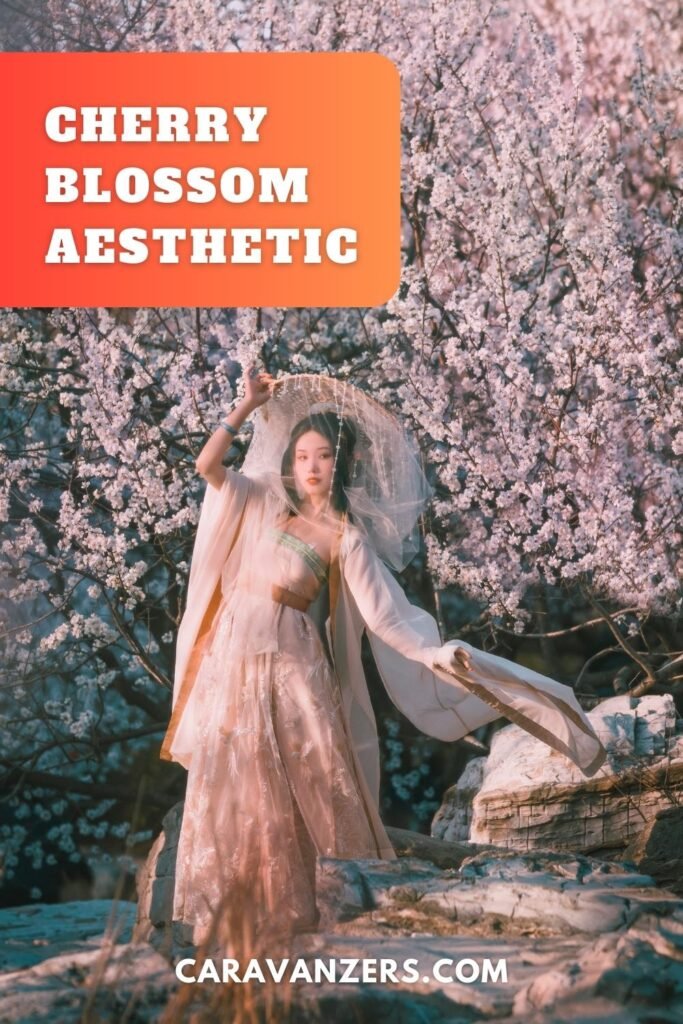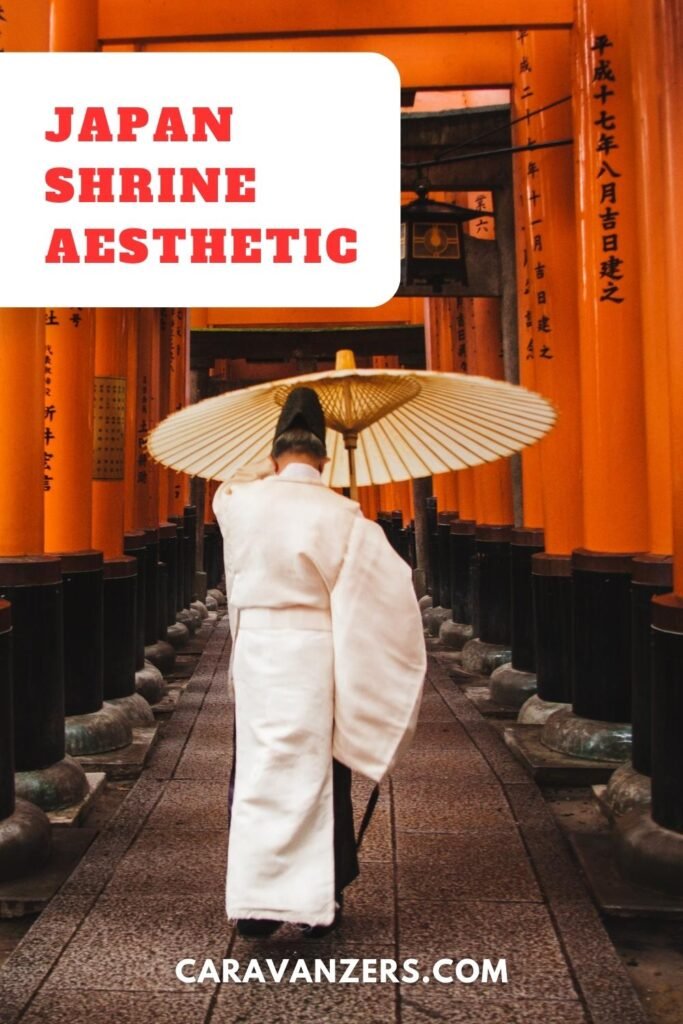
Japan travel aesthetic. From cherry blossoms to temple chic, a Japanese is here to tell you all the groovy ones to be part of.
In this guide, I’m going down the list of the best ways to incorporate Japanese aesthetics into your trip next time you come to my country.
First of all, I want to tackle the issue of cultural appropriation versus honest interest in culture during your travels.
Participating in an aesthetic in a particular culture is about respectfully embracing and celebrating its traditions with consent and understanding.
Cultural appropriation, on the other hand, is about the inappropriate borrowing of elements from a marginalized culture without acknowledgment, often perpetuating stereotypes and disrespecting its significance, leading to cultural insensitivity and harm.
So, as you go through Japan, experiment with some of these and know you aren’t doing anything wrong!
Cherry Blossoms

Cherry blossoms are popular for their captivating beauty and have become an enchanting travel aesthetic for many wanderers seeking nature’s ephemeral marvels.
As spring sweeps across certain Japanese regions, these delicate flowers paint the landscape with soft pastels.
So, carry blossoms infuse the landscape with an air of romance and serenity, and this is what makes them unique.
The sight of cherry blossoms in full bloom offers a fleeting yet profound experience. It evokes a sense of fleeting beauty and the transience of life.
Meanwhile, amidst the gentle rustling of petals in the breeze, visitors find themselves drawn into a world of tranquility and contemplation.
The charm of cherry blossoms lies not only in their visual appeal but also in the atmosphere they create, where strangers bond over shared admiration for this natural spectacle.
As a result, parks and gardens bedecked with these blossoms become lively hubs of jubilation, where people gather to celebrate the annual bloom.
Generally speaking, this creates a delightful symphony of laughter and joy.
Traveling to witness cherry blossoms is an immersive encounter with the splendor of nature’s artistic prowess.
Photographers, artists, and dreamers find inspiration in the delicate yet bold display of these fleeting flowers.
Their allure lies in their simplicity, which draws travelers from afar to witness their enchanting allure.
So, as you venture into this aesthetic journey, you’ll discover that cherry blossoms are not merely a sight but an evocative experience, etching lasting memories in the hearts of all who encounter their ephemeral grace.
Bamboo Forests
Bamboo is a captivating element of Japan’s travel aesthetic, reflecting the country’s deep connection with nature and traditions.
So, the slender shoots symbolize resilience and flexibility, and it creates a vibe that resonates with the Japanese spirit.
When strolling through bamboo groves, a serene ambiance envelops you.
Likewise, the rustling leaves create a meditative soundscape, which invites reflection.
In Japan, bamboo holds a revered position in culture, from tea ceremonies to traditional craftsmanship.
Also, its elegance inspires artists and designers.
Walking along bamboo-covered pathways offers a respite from urban life, and it brings balance and harmony.
Bamboo’s timeless charm embodies Japan’s travel aesthetic – a blend of natural beauty, cultural heritage, and a tranquil escape from modernity.
Zen Gardens
When traveling through Japan, one captivating travel aesthetic that often captivates visitors is the Zen garden.
For example, these gardens are well known for their serene and contemplative atmosphere, which creates a unique sense of tranquility.
The Zen gardens are meticulously designed and harmoniously combine elements such as rocks, gravel, moss, and carefully placed greenery.
Likewise, the gardens follow a minimalist and balanced approach, where every element serves a purpose in evoking a sense of natural beauty and inner peace.
Similarly, the arrangement of rocks symbolizes mountains and islands, while the raked gravel patterns mimic the flow of water.
The carefully tended moss adds a touch of softness and elegance to the landscape.
Beyond their physical beauty, these gardens also possess a profound spiritual aspect.
They are deeply rooted in Zen Buddhism and offer a space for meditation and reflection.
Visitors often find themselves drawn to the gardens’ simplicity and the opportunity to embrace a moment of mindfulness amidst the busyness of modern life.
Whether found in traditional temples or modern settings, Zen gardens continue to be an integral part of Japanese culture.
Temples and Shrines

When exploring Japan, one captivating travel aesthetic that you’ll encounter is the temples and shrines.
These sacred sites hold great cultural significance and offer a window into Japan’s rich religious heritage.
For example, temples and shrines are abundant throughout the country, each possessing unique architectural styles and historical backgrounds.
Temples, often associated with Buddhism, are characterized by their grand structures, intricate wooden carvings, and stunning pagodas.
They serve as places of worship, contemplation, and study of Buddhist teachings. As a result, visitors may witness the monks’ rituals.
On the other hand, shrines are dedicated to the Shinto religion, Japan’s indigenous belief system.
These sanctuaries boast distinctive torii gates, often painted in vibrant red and symbolizing the boundary between the sacred and profane.
Enclosed within natural surroundings, Shinto shrines offer a profound connection to nature and its spiritual essence.
Meanwhile, both temples and shrines exhibit meticulous attention to detail, reflecting the deep reverence Japanese people hold for their traditions and customs.
Therefore, visitors are encouraged to partake in cleansing rituals and respect local customs when entering these sacred spaces.
Finally, these temples and shrines contribute significantly to Japan’s cultural identity, attracting travelers seeking an authentic experience that intertwines spirituality with architectural splendor and historical significance.
Japanese Cuisines
When going on a trip through Japan, one captivating travel aesthetic that you’ll undoubtedly encounter is the rich and diverse food culture.
Japanese cuisine is definitely famous for its artful presentation, meticulous preparation, and exquisite flavors.
From lively city streets to quaint rural towns, food plays a central role in the Japanese way of life.
For example, each region has unique culinary specialties, and they reflect local ingredients, traditions, and customs.
Traditional dishes such as sushi, sashimi, tempura, and ramen give you a yummy balance of taste and texture.
Likewise, the attention to detail in Japanese cuisine extends beyond the taste itself.
The visual aspect of the dishes is equally essential, and chefs take great care in arranging the food to create aesthetically pleasing presentations.
This artistry elevates the dining experience and makes every meal an opportunity to indulge in a multi-sensory journey.
Moreover, dining in Japan is often a communal experience, with the act of sharing and enjoying food together being a significant part of the country’s culture.
Meanwhile, food in Japan is a gateway to understanding the country’s history and customs.
Some dishes have ancient origins and are steeped in cultural significance, while others have evolved over time to adapt to modern tastes and preferences.
For travelers, exploring the food scene in Japan becomes an adventure in itself, with countless opportunities to savor new flavors and immerse oneself in the local way of life.
Tea Ceremonies
When traveling in Japan, one culturally significant experience is the tea ceremony.
Rooted in the traditional practice of Chanoyu, the tea ceremony is a revered art form that dates back centuries.
It embodies a profound sense of harmony, mindfulness, and hospitality.
So, tea ceremonies are usually conducted in serene and beautifully designed tea rooms, which serve as an oasis of tranquility amidst the bustling world outside.
The ritual is meticulously choreographed, with each movement and gesture carrying symbolic meaning and intention.
Likewise, the preparation and serving of matcha, a powdered green tea, is at the heart of the ceremony.
The tea master, known as the “chashou,” carefully crafts the tea with utmost precision and attention to detail.
Afterward, guests are invited to partake in this meditative experience, where sipping the tea becomes an opportunity for self-reflection and appreciation of the present moment.
Meanwhile, beyond the act of drinking tea, the tea ceremony embodies a spirit of hospitality and respect.
The act of receiving and offering tea is a gesture of kindness and grace, and this really creates space for meaningful interactions and cultural exchange.
Finally, attending a tea ceremony during your travels in Japan will give you a window into the nation’s traditional values, aesthetics, and profound respect for ritual.
Geisha Culture

When exploring Japan, one significant travel aesthetic is the geisha culture, which is rooted in centuries of tradition.
Geisha are highly skilled and trained female performers who epitomize grace, artistry, and elegance.
So, geisha culture is deeply entwined with history and the arts, with geisha themselves being accomplished musicians, dancers, and conversationalists.
Their immaculate appearance, characterized by elaborate hairstyles, exquisite kimonos, and striking makeup, adds to the allure of their mystique.
Likewise, geisha entertain guests through traditional performances, such as playing musical instruments like the shamisen, performing traditional dances like the Kyoto-style dance called “Kyo-mai,” and engaging in witty conversation and games.
Their refined social skills make them adept at creating a captivating and enjoyable atmosphere for their patrons.
Meanwhile, behind their enchanting facade lies rigorous training and dedication.
Young girls, known as “maiko,” undergo years of apprenticeship to become full-fledged geisha.
During this period, they learn various arts, etiquette, and the intricacies of geisha culture, all while living in special houses known as “okiya.”
Geisha districts, known as “hanamachi,” are found in cities like Kyoto and Tokyo, where visitors can use the charm of this unique culture in an overall travel aesthetic.
These districts host traditional tea houses and ochaya (tea rooms), where guests can partake in exclusive geisha performances and experiences.
So, observing their performances and engaging with geisha in an authentic setting offers travelers a profound appreciation for the traditions, craftsmanship, and enduring allure of this captivating travel aesthetic.
City Nightlife
When venturing into Japanese cities, one lively travel aesthetic is the nightlife.
Japanese cities come alive after dark with pulsating energy and a kaleidoscope of sights and sounds.
City nightlife in Japan is a reflection of the country’s modernity and innovative spirit.
The streets are adorned with neon lights and billboards that illuminate the urban landscape in a mesmerizing display of colors.
So, this futuristic glow creates an unmistakable atmosphere that sets the stage for an unforgettable experience.
Meanwhile, Japanese nightlife is a fusion of tradition and contemporary culture.
While modern establishments offer trendy and dynamic experiences, travelers may also indulge in traditional entertainment forms like karaoke and izakaya (Japanese pubs).
These venues provide a chance to connect with locals and experience Japan’s social fabric firsthand.
Additionally, night markets and food stalls are delightful culinary adventures that serve up an array of yummy street food options.
From savory takoyaki to sweet taiyaki, visitors may savor a diverse range of flavors while strolling through bustling alleyways.
So, yes, the lively streets, lively entertainment, and culinary experiences converge to create a captivating travel aesthetic that captures the essence of modern Japan.
Cosplay

When diving into Japanese culture, one travel aesthetic that emerges is the phenomenon of cosplay.
Short for “costume play,” cosplay is a distinctive subculture where enthusiasts dress up as characters from anime, manga, video games, and other forms of media, including Japanese pop music.
So, cosplay in Japan goes beyond mere costume-wearing; it represents a passionate expression of fandom and creativity.
Enthusiasts invest considerable money, time, and effort in meticulously recreating their chosen characters’ appearances, including intricate costumes and elaborate makeup.
Meanwhile, the lively culture of cosplay finds its stage at events like anime conventions, known as “comiket” or “anime expos.”
Likewise, the cosplay community in Japan extends its influence beyond events, with certain districts in Tokyo, such as Akihabara and Harajuku, serving as hubs for cosplay enthusiasts.
So, participating in or witnessing cosplay in Japan allows travelers to be part of the excitement and dedication of the cosplay subculture.
Salaryman
When exploring Japan, one intriguing travel aesthetic that may stand out to you is the concept of the “salaryman.”
This term refers to the iconic white-collar office workers, predominantly male, who are a prominent fixture in the country’s business culture.
Salarymen are recognizable by their formal business attire, which typically consists of dark suits, white shirts, and ties.
They are an embodiment of professionalism and diligence, often seen commuting en masse on crowded trains during rush hours.
As a travel aesthetic, observing the salaryman offers insights into Japan’s corporate world and its values of discipline, loyalty, and dedication to one’s profession.
For travelers, witnessing the salaryman in action provides a glimpse into the daily routines and routines of these dedicated workers.
The bustling business districts, such as Tokyo’s Marunouchi and Osaka’s Umeda, have the most opportunities to observe the salaryman lifestyle up close.
Hey, you may even want to grab a selfie ahead of a crowd of them during lunch!
Final Thoughts – Japanese Travel Aesthetics
As you probably already know, thanks to social media, travel aesthetics has become a huge part of our trips.
Travelers love incorporating aesthetics into their destination trips because it enhances their immersive experience, connects them to the local culture, and allows them to appreciate the unique beauty of the place.
In my humble opinion, travel aesthetics fosters a deeper understanding of traditions and offers opportunities to capture stunning visuals and create lasting memories.
So, that’s why I’ve shared with you all these amazing ways you can incorporate elements of our culture into your trip.
Enjoy Japan!
Yuri Takahashi writes about Japan for Caravanzers.
Follow us on Pinterest.
